What You’ll Need to Set Up Your Amazon Purchase Bot
Author: Stellar AIO
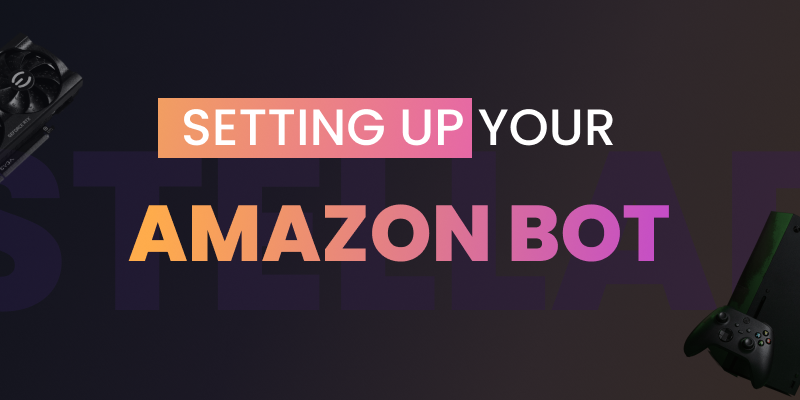
6 Things to Have Before You Set Up Your Amazon Purchase Bot
1. List of Items and Their ASIN
Each item on Amazon has a unique Amazon Standard Identification Number (ASIN), which differentiates one product from another. This number can be found in the product’s URL on Amazon.
For example, the ASIN for a PS5 Digital Edition is B08FC6MR62, whereas that of an Nvidia RTX 3070 graphics card is B08MT6B58K.
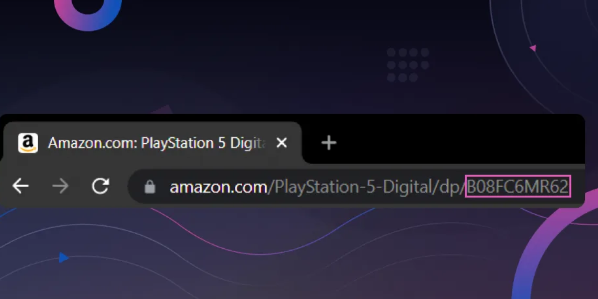
You can pull that information manually or check if your Amazon purchase bot or cook group has an existing list of profitable items and their respective ASINs.
P.S: Some Amazon auto checkout bots may require you to use an Offer ID instead of an ASIN. Check your bot’s setup guides for more info.
2. Latest Bot and Release Guides
You’ll need to stay up-to-date with the latest bot changes. Keep a close eye on new updates, as that may change the way you’ll need to set it up for future releases.
Also, the latest release guides are super helpful as they detail the recommended way to set up for an upcoming release.
So if you’re renting an Amazon purchase bot from someone and don’t have access to its Discord, then make sure your renter sends you the latest guides and keeps you posted with all the recent updates.
3. Monitors
Monitors are essential for Amazon botting. Their role is to regularly check the Amazon site to see if any profitable items have dropped.
Typically your bot’s Discord will provide you with monitors which typically show you the item’s ASIN and Offer ID
There are also many other Discord groups, including free ones, that have Amazon monitors.
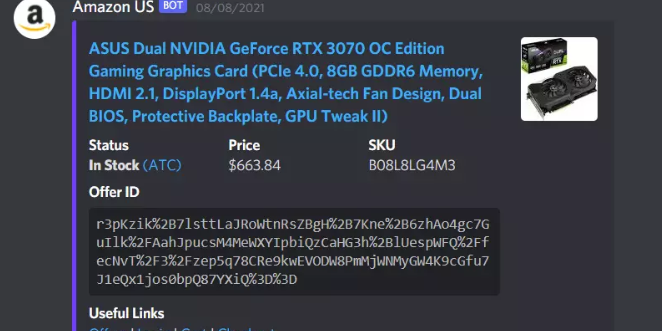
4. Shipping and Billing Information
This is an obvious one. You’ll need to ensure you have a shipping address and at least one card number that works on Amazon.
If you plan to buy multiples of the same item, you’ll need to acquire or “generate” several card numbers. You’ll also need to “jig” your address if you don’t have multiple shipping addresses.
I go over both in further detail towards the end of this post.
5. Proxies
Without proxies, your chances of success on Amazon are slim to none.
If you’re new to botting and are not sure what a proxy is, I recommend you check this guide.
I’ve dedicated an entire section below for the best proxies to use for your Amazon shopping bot.
6. Amazon Accounts
When botting, you must run every bot task with an Amazon account. It is always recommended to sign up for as many Amazon accounts as possible since you’re bound to get some accounts flagged.
If you’re finding it tough to create accounts manually, you can always use a tool like AYCD Account Generator that can create dozens of unique Amazon accounts for you.
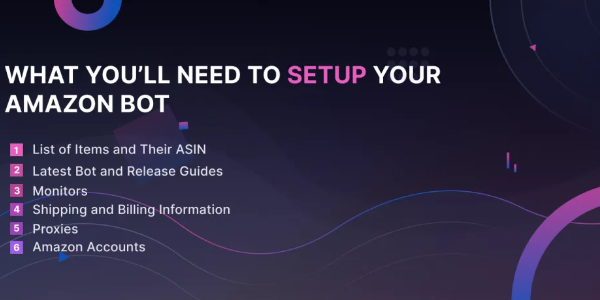
If You Plan to Use Your Bot to Purchase Dozens of Items, Read This First
Is It Easy to Scale Up Your Bot Setup?
If done right, Amazon botting can be very lucrative; a single graphics card or console can net you hundreds of dollars in profit if you plan on reselling them.
But how easy is it to scale up your botting operations on Amazon?
Quite frankly, it’s not straightforward.
If you’re looking to buy several PS5s and GPUs, you need to have a top-performing Amazon purchase bot and high quality proxies. Figuring the best combination is not simple, as it requires extensive trial and error.
Assuming you get that part figured, there is no guarantee you’ll cop multiples.
On top of that, Amazon makes it tougher on you. The site may flag some of your accounts or even cancel your orders if they suspect you’re using an automated tool or the same shipping address.
Eventually, you’ll figure out the winning combination. It takes time to reach a point where you consistently acquire multiple items on the same release without experiencing order cancellations.
Practical Tips on Scaling up Your Bot Setup
To properly scale your setup, you’ll need multiple shipping addresses, card numbers, phone numbers, and email addresses.
Acquiring all that info may seem complicated, but it’s pretty simple.
Here is a list of practical tips you can follow to reduce cancellations when buying in bulk using your Amazon purchase bot:
• Jig your shipping address for each billing profile. The goal is to make each address look unique, even if you only have one address. You can check this guide to get a better idea of how to jig your address.
• If you don’t have enough physical cards, you can generate virtual cards. Services like Privacy allow you to accomplish that. This video further explains the process.
• You don’t actually have to own multiple phone numbers, as you can just make them up. Amazon does not verify your phone number for any of its purchases.
• Don’t forget to create multiple emails and Amazon accounts. Some tools on the market can help generate these in bulk, but you can always start by making them yourself.
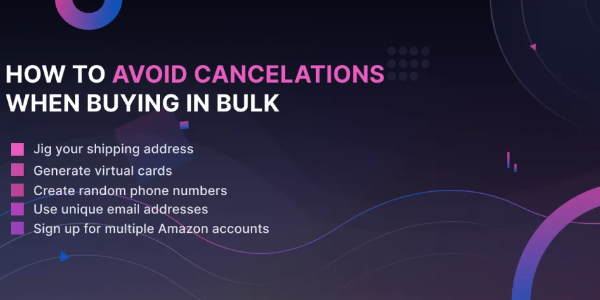
Types of Proxies Used On Amazon
You’ll see botters using two types of proxies on Amazon: ISP and Residential proxies.
It’s not always clear which proxy type is better to run with your Amazon purchase bot.
Personally, I always recommend running a mix of both whenever possible.
However, I wanted to get the opinions of different proxy providers. So I reached out to a couple and asked what they’d recommend I use on Amazon. Here’s what they had to say:
“I would recommend ISPs for Amazon” – Stella Proxies.
“Use ISP for both PS5 and GPU restocks” – Oculus Proxies.
“I would recommend using resis for Amazon restocks. Same goes for GPU restocks. However, do check with your bot regarding which proxies would work best as well.” – Leaf Proxies
“ISP works well on Amazon” – Cookie Proxies
Unlike the Walmart bot recommendations, ISPs seemed to be the more popular choice for Amazon. However, it’s always best to ask your bot support staff and see what they recommend.
It is not always clear when one proxy type will perform better than the other, so you can play it safe and run a mix of ISPs and residentials.
Consider Joining a Cook Group to Improve Your Botting Skills
A cook group is a community managed by expert botters and resellers whose primary goal is to help you make more money.
Cook groups are a great starting place for newcomers as it helps them acclimate to the botting scene much faster.
Membership fees of such groups typically range from $25-80 per month. More experienced groups justifiably charge higher prices as you’re more likely to see quality results.
People that run cook groups tend to be experienced botters and resellers and are familiar with the ins and out of botting.
By joining a cook group, you’ll also get access to release guides and blazing fast monitors that notify you when profitable items are dropping.
Of course, there are different cook groups with varied specializations. If you want to become better at using your Amazon purchase bot, you’ll need to join a group that provides killer info in the retail botting niche.
Flipseek, Malice, Flipd, and Hidden Society are all examples of premium groups that will elevate your botting game to the next level.
Note that such groups are difficult to get into since they keep their membership spots limited. Until positions open up again for these groups, you’ll have to settle for less exclusive groups.
Conclusion
To sum up, here are some of the main things you’ll need to start setting up your Amazon purchase bot:
• Have a specific list of items you’ll be buying
• Get access to all the latest bot guides
• Have a reliable Discord monitor to track restocks
• Prepare your billing and shipping profile(s)
• Purchase proxies suitable for Amazon botting
• Register for multiple Amazon accounts
• Join a cook group specialized in retail botting
That is pretty much everything you will need to get started.
The next step will be to start running for releases.
You will likely have to run multiple drops before you start seeing significant results.
Don’t expect results overnight!
Botting is a marathon, not a sprint.
It will take time to experience success, and it’s important to remain persistent throughout the process.
